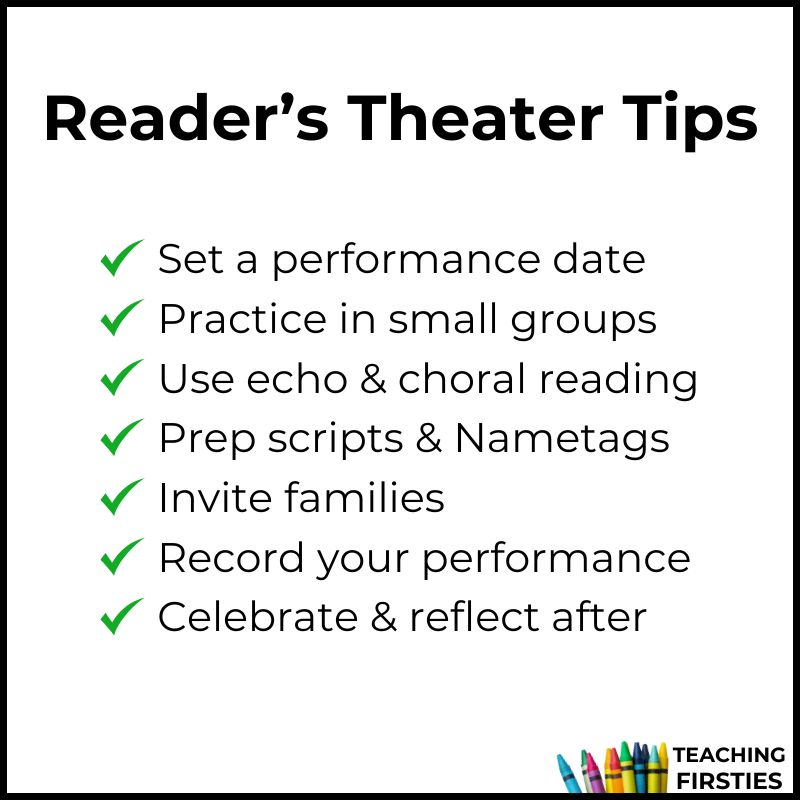Readers Theater performances are a practical way to wrap up your fluency instruction while giving students a clear purpose for repeated reading. A classroom performance reinforces skills like expression, pacing, and collaboration—without the pressure of memorization. It also gives families a chance to see student growth in action.
Whether you’re planning your first performance or looking to streamline the process, this guide offers clear, actionable steps to help you organize a Readers Theater event that supports instruction and celebrates your students’ progress.
Organizing Readers Theater Shows
A classroom performance gives students a real reason to practice with purpose. It’s not just about putting on a show, it’s about reinforcing fluency, encouraging accountability, and building confidence in a low-stress setting.
- Goal Setting: When students know they’ll be performing, they take practice more seriously. It turns repeated reading into preparation with a clear objective.
- Ownership of Learning: Preparing for a Readers Theater performance helps students pay attention to their own fluency. This includes working on pacing, expression, and accuracy with more intention.
- Public Speaking Practice: Readers Theater offers a supportive way to build speaking skills. Because students read from scripts, the pressure of memorization is removed, making it easier for them to focus on how they deliver their lines.

Teacher Tip: Set the performance date early and add it to your class calendar. This builds excitement and gives students a clear timeline to track their progress and stay focused during practice.
Preparing Students for Performance Day
Structured rehearsals help students feel ready and confident when it’s time to perform. By building fluency into your routine and breaking practice into manageable steps, you set students up for success on performance day.
- Echo and Choral Reading: Start with echo reading—read a line aloud and have students repeat it, matching your tone and expression. Then move to choral reading so students can practice rhythm and fluency together.
- Partner and Small Group Rehearsals: Let students practice in pairs or small groups. This gives them more time to read and creates space for peer feedback. Smaller groups also make it easier to support students who need extra help with fluency.
- Full Group Run-Throughs: As performance day approaches, schedule full class rehearsals. This helps students understand how the script flows, when it’s their turn to read, and how to handle transitions.
- Visual Countdown: Post a countdown to the performance and mark rehearsal milestones. This visual keeps the goal in sight and helps students stay focused and motivated.
Teacher Tip: Plan a “dress rehearsal” with a small audience—another class, reading buddies, or a few staff members. It’s a simple way to give students practice performing in front of others without the pressure of families watching just yet.
Setting Up for Success: What to Expect
A well-prepared performance space helps things run smoothly and supports student focus. You don’t need a stage, just a simple, organized setup that works for your classroom.

- Stage Arrangement: Choose a setup that fits your space. Students can sit in a semi-circle, stand behind desks, or use an open area at the front of the room. Make sure every student is visible and can see their peers to support smooth cues and interactions.
- Use of Visual Aids: Give each student a script folder to keep lines organized. Add name tags or simple costumes to help identify characters. For younger students, character puppets or small props can add interest and help them stay in the character role without being a distraction.
- Managing Transitions: Take time to rehearse how students will move on and off “stage,” pass props, or switch scenes. Practicing these small transitions keeps the performance running without interruptions and builds student confidence.
Organizational Tip: Store scripts, props, and visuals in labeled folders or bins like this one that are thin enough to stack and store multiple Readers Theater scripts. This keeps materials easy to access and helps students stay responsible for their own setup during rehearsals and on performance day.
Involving Families and Guests
Inviting families to your Readers Theater performance helps build a strong connection between home and school while giving students a meaningful audience for their hard work.
- Invitations: Send home simple invitations or printable “theater tickets.” This adds a special touch and helps students feel proud and excited about sharing their progress.
- Setting Expectations: Let families know what the performance is, and what it’s not. Explain that the focus is on reading fluency, not memorization or acting. This helps everyone appreciate the purpose behind the event and supports students in feeling confident and successful.
- Virtual Options: If families can’t attend in person, consider recording the performance or sharing a live video link. This ensures every student has someone cheering them on, even from afar.

Bonus Idea: Create a small photo area with a themed backdrop or props related to the script. It’s a simple way for families to snap a picture with their child and makes the day feel even more memorable.
Post-Show Reflection and Celebration
Taking time to reflect after the performance helps students recognize their growth and brings a strong close to the experience.
- Class Reflection: Lead a structured discussion to help students think about what they learned. Ask questions like: What part of the performance did you enjoy the most? Where do you think you made the most progress? What was challenging, and how did you work through it? What would you do differently next time?
- Recognition: Acknowledge every student’s effort with a personalized certificate or small award. Keep categories meaningful and skill-based—like “Most Improved Reader,” “Clear Voice Award,” or “Strongest Teamwork.” These reinforce the reading goals behind the performance.
- Student Input: Let students suggest or vote on future scripts. This keeps them engaged and gives them a sense of ownership in what comes next.
Celebration Idea: Consider a small, informal gathering after the show. Invite families and staff to enjoy light refreshments and recognize the students’ work together. It doesn’t have to be elaborate—just a thoughtful way to celebrate progress and end on a positive note.
Readers Theater Performance Recap
Organizing a Readers Theater performance doesn’t need to feel overwhelming. With a few simple systems in place, you can turn your regular fluency practice into a purposeful event that highlights student progress.
These performances give students the chance to read with intention, reflect on their growth, and take pride in their hard work—while reinforcing essential fluency skills like expression, pacing, and accuracy.
From setting rehearsal routines to involving families and celebrating success, each part of the process supports confident, capable readers.

Related Readers Theater Resources
Looking to build a strong foundation for Readers Theater in your classroom? These blog posts offer practical strategies and step-by-step support to guide you through every part of the process—from getting started to assessment:
- Getting Started with Readers Theater
- 7 Strategies to Make Readers Theater Fun for First Graders
- How to Assign Readers Theater Roles Fairly
- Matching Readers Theater Roles to Reading Levels
- Choosing the Right Readers Theater Scripts
- Setting Behavior Expectations for Readers Theater
- How to Structure Readers Theater Practice Sessions
- Organizing Readers Theater Materials to Keep Practice Running Smoothly
- How to Build Reading Fluency with Readers Theater in Your Classroom
- Why Assessing Readers Theater Matters—And How to Do It Well
Each post is designed to help you implement Readers Theater with clarity, purpose, and confidence—all while keeping student growth at the center of your instruction.
Looking for ready-to-go scripts to get started?
Explore the full collection of Readers Theater scripts at Literacy Stations—each set includes pre-highlighted scripts, visual aids, and digital options to help you save time and give your students the structure they need for effective fluency practice.





